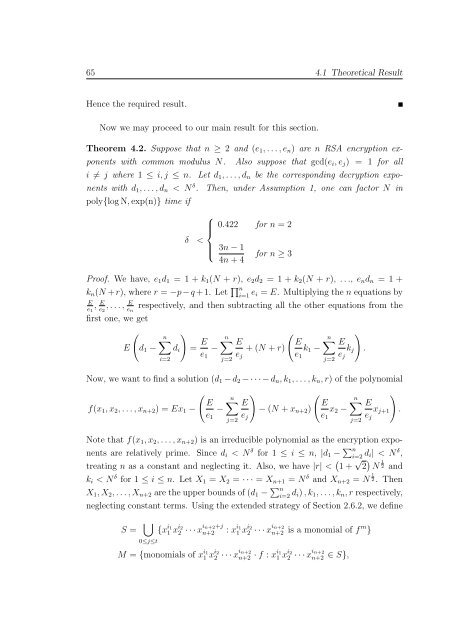Cryptanalysis of RSA Factorization - Library(ISI Kolkata) - Indian ...
Cryptanalysis of RSA Factorization - Library(ISI Kolkata) - Indian ...
Cryptanalysis of RSA Factorization - Library(ISI Kolkata) - Indian ...
You also want an ePaper? Increase the reach of your titles
YUMPU automatically turns print PDFs into web optimized ePapers that Google loves.
65 4.1 Theoretical Result<br />
Hence the required result.<br />
Now we may proceed to our main result for this section.<br />
Theorem 4.2. Suppose that n ≥ 2 and (e 1 ,...,e n ) are n <strong>RSA</strong> encryption exponents<br />
with common modulus N. Also suppose that gcd(e i ,e j ) = 1 for all<br />
i ≠ j where 1 ≤ i,j ≤ n. Let d 1 ,...,d n be the corresponding decryption exponents<br />
with d 1 ,...,d n < N δ . Then, under Assumption 1, one can factor N in<br />
poly{logN,exp(n)} time if<br />
⎧<br />
⎪⎨<br />
δ <<br />
⎪⎩<br />
0.422 for n = 2<br />
3n−1<br />
4n+4<br />
for n ≥ 3<br />
Pro<strong>of</strong>. We have, e 1 d 1 = 1 + k 1 (N + r), e 2 d 2 = 1 + k 2 (N + r), ..., e n d n = 1 +<br />
k n (N+r), where r = −p−q+1. Let ∏ n<br />
i=1 e i = E. Multiplying the n equations by<br />
E<br />
e 1<br />
, E e 2<br />
,..., E e n<br />
respectively, and then subtracting all the other equations from the<br />
first one, we get<br />
E<br />
(<br />
d 1 −<br />
)<br />
n∑<br />
d i = E −<br />
e 1<br />
i=2<br />
n∑<br />
j=2<br />
(<br />
E E<br />
+(N +r) k 1 −<br />
e j e 1<br />
n∑<br />
j=2<br />
)<br />
E<br />
k j .<br />
e j<br />
Now, we want to find a solution (d 1 −d 2 −···−d n ,k 1 ,...,k n ,r) <strong>of</strong> the polynomial<br />
f(x 1 ,x 2 ,...,x n+2 ) = Ex 1 −<br />
(<br />
E<br />
e 1<br />
−<br />
n∑<br />
j=2<br />
) (<br />
E E<br />
−(N +x n+2 ) x 2 −<br />
e j e 1<br />
n∑<br />
j=2<br />
)<br />
E<br />
x j+1 .<br />
e j<br />
Note that f(x 1 ,x 2 ,...,x n+2 ) is an irreducible polynomial as the encryption exponents<br />
are relatively prime. Since d i < N δ for 1 ≤ i ≤ n, |d 1 − ∑ n<br />
i=2 d i| < N δ ,<br />
treating n as a constant and neglecting it. Also, we have |r| < ( 1+ √ 2 ) N 1 2 and<br />
k i < N δ for 1 ≤ i ≤ n. Let X 1 = X 2 = ··· = X n+1 = N δ and X n+2 = N 1 2. Then<br />
X 1 ,X 2 ,...,X n+2 aretheupperbounds<strong>of</strong>(d 1 − ∑ n<br />
i=2 d i),k 1 ,...,k n ,r respectively,<br />
neglecting constant terms. Using the extended strategy <strong>of</strong> Section 2.6.2, we define<br />
S = ⋃<br />
0≤j≤t<br />
{x i 1<br />
1 x i 2<br />
2 ···x i n+2+j<br />
n+2 : x i 1<br />
1 x i 2<br />
2 ···x i n+2<br />
n+2 is a monomial <strong>of</strong> f m }<br />
M = {monomials <strong>of</strong> x i 1<br />
1 x i 2<br />
2 ···x i n+2<br />
n+2 ·f : x i 1<br />
1 x i 2<br />
2 ···x i n+2<br />
n+2 ∈ S},
















